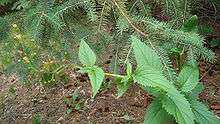Scrophularia lanceolata
| Scrophularia lanceolata | |
|---|---|
 | |
| Scientific classification | |
| Kingdom: | Plantae |
| (unranked): | Angiosperms |
| (unranked): | Eudicots |
| (unranked): | Asterids |
| Order: | Lamiales |
| Family: | Scrophulariaceae |
| Genus: | Scrophularia |
| Species: | S. lanceolata |
| Binomial name | |
| Scrophularia lanceolata Pursh | |
Scrophularia lanceolata is a species of flowering plant in the figwort family known by the common name lanceleaf figwort. It is native to North America, where it is known from western and eastern Canada and much of the United States except for the southeastern quadrant.[1] It grows in many types of habitat, sometimes including disturbed areas such as roadsides. It is a perennial herb producing clusters of erect or spreading stems up to 1.5 meters long. The oppositely arranged leaves have toothed, triangular or lance-shaped blades up to 14 centimetres (5.5 in) long which are borne on short petioles. The inflorescence is a wide-open panicle with several hairy, glandular branches bearing flowers. The flower has a spherical or urn-shaped corolla opening at the top into a narrow mouth edged with hoodlike lobes. The corolla is roughly 1–1.5 centimetres (0.39–0.59 in) long and is greenish tinged with brown or dull pink. The wide staminode is generally visible in the mouth of the corolla. The fruit is a capsule just under a centimeter long containing many seeds.
References
- ↑ "Lanceleaf figwort". USDA. Plants Profile. Retrieved July 10, 2010.